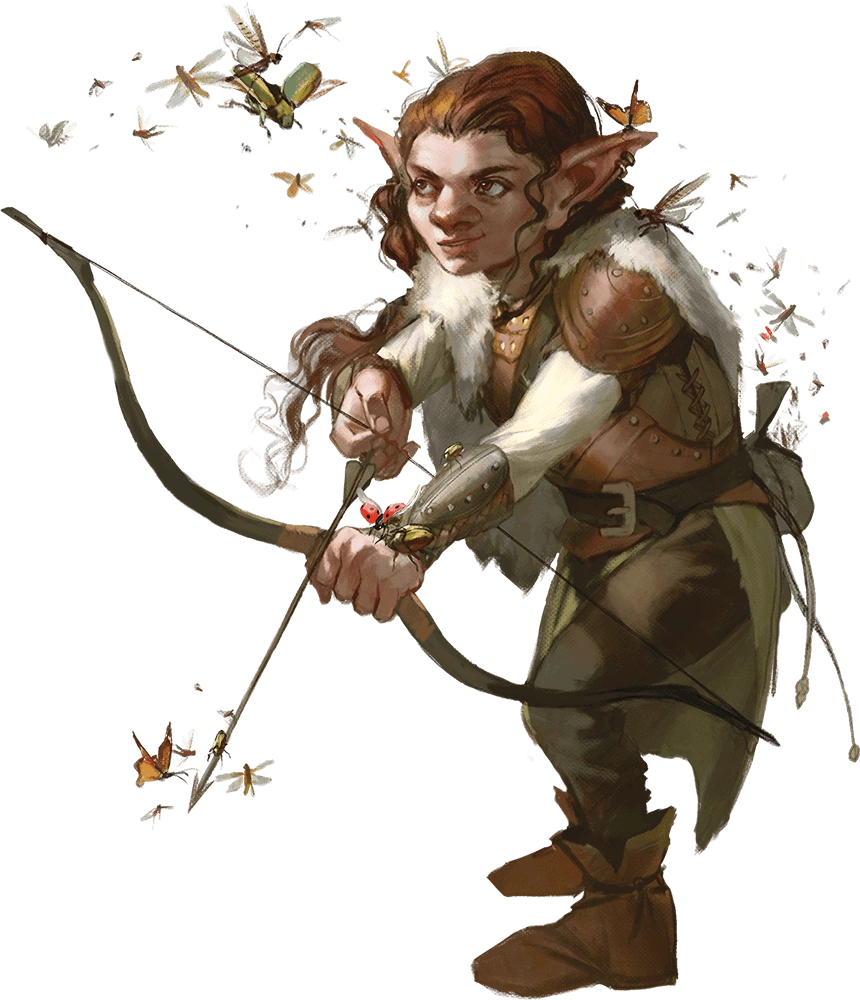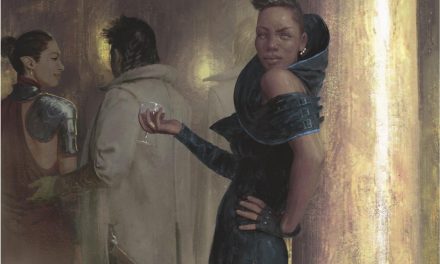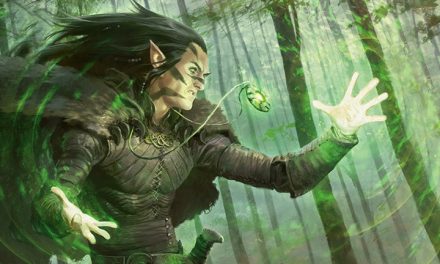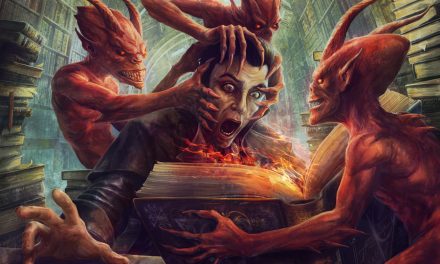The common Ranger archetype is that they have some kind of animal companion. However, the Swarmkeeper Ranger says “why not literally thousands of companions?!”
It’s actually a pretty fascinating thing: a huge of amount of creatures working together as a collective whole.
Leading, controlling, and taking care of this gathering of creatures is the Ranger. Whether it’s a swarm of bees, rats, pixies, birds, or whatever else, it’s definitely a sight to behold!
Do you wish to take your place as the head of such a swarm?
Here is your chance!
This is the full guide to the Swarmkeeper Ranger in D&D 5e!
What is the Swarmkeeper Ranger in D&D 5e?
Rangers are known for the supernatural bonds that they form with nature and the spirits that reside in it.
As it just so happens, Swarmkeeper Rangers have made hundreds or even thousands of such bonds!
These spirits manifest as a swarm of a certain type of creatures. Working and moving together, the swarm and Ranger become as one.
Whether dealing with enemies in combat or offering solutions and utility to certain practical problems, it’s quite the partnership!
While the mechanics of the Swarmkeeper Ranger are certainly fun, there’s also a ton of descriptive and roleplay potential here too. Sticking with the concept of your friendly swarm, there is no shortage of ways to flavor your spells and features!
The Swarmkeeper Ranger appears alongside the Fey Wanderer Ranger in Tasha’s Cauldron of Everything.
Role in the Party
The Swarmkeeper Ranger fills the same roles that you would expect from pretty much any Ranger.
Scouting, survivability, and focusing down high-priority enemies are all still essential aspects of what these characters bring to the party.
But the Swarmkeeper also brings some interesting strategic utility to the table.
Fittingly enough for a class that’s all about swarms of creatures, they play WONDERFULLY to the group’s tactics.
Using their swarm to move enemies around and their spells to bring some extra control effects into combat, Swarmkeeper Rangers are team players through and through!
So even beyond dealing damage and tracking foes, you can count on these characters to set up their allies for some devastating combos.
From the very first time you have your swarm deliver an enemy straight to your party’s raging Barbarian, there will be no question about what you bring to the team!

Swarmkeeper Ranger Features 5e
Unsurprisingly, the core feature of the Swarmkeeper Ranger is their Gathered Swarm.
As you level up, the swarm grows in power (and probably size too!).
Even beyond dealing extra damage to enemies, your swarm is able to move you or your enemies around in ways that open up a ton of tactical options.
Eventually, the swarm will be able to provide cover for you and even enable you to fly or teleport!
Related: Hunter’s Mark in D&D 5e Explained
Swarmkeeper Magic (Level 3)
Choosing the Swarmkeeper Ranger subclass gives you access to more spells as you reach certain levels.
These spells count as Ranger spells for you and do not count against the number of Ranger spells that you know. As with your other Ranger spells, Wisdom is your spellcasting ability for these.
| Ranger Level | Spell |
| 3 | Faerie Fire, Mage Hand |
| 5 | Web |
| 9 | Gaseous Form |
| 13 | Arcane Eye |
| 17 | Insect Plague |
If you don’t already know the Mage Hand cantrip, you gain that at level 3 as well. For you, the hand takes the form of your swarming nature spirits. It’s a simple but infinitely useful cantrip that’s great to have!
Faerie Fire is one of my favorite spells. Not only are you able to root out invisible enemies, but you’re also giving yourself and your allies advantage on attacks against those who fail their save against this spell.
Used cleverly, Web is a great way to lockdown an entire portion of the map. Used in combination with your Gathered Swarm movement options, this can be a complete nightmare for your foes. They might break free only to be throw back into the web again if they don’t destroy it!
Situations where you need to get in or out of somewhere/something are where Gaseous Form shines. You don’t move particularly quickly, but you can slip through even the smallest openings with ease.
Arcane Eye is a fantastic and reliable way to do some scouting in safety. Despite getting this later in the game, it’s a wonderful option to have.
I get why Insect Plague is on this list and it makes sense thematically, but I’m not so crazy about the spell itself. Enemies (especially at this level) will likely have good Constitution saving throws and your (likely low) spell save DC doesn’t help matters.
Still, it can be handy if you have a way to trap enemies in with your insects for the duration or can use it to cause havoc in a choke point on the map.

Gathered Swarm (Level 3)
Beyond your Swarmkeeper Magic, we’re kicking things off at level 3 with the Swarmkeeper Ranger’s core feature.
With Gathered Swarm, you are able to summon a swarm of creatures to assist you.
Until you die, the swarm remains in your space, crawling on you or flying and skittering around you within your space.
Once on each of your turns, you can cause the swarm to assist you in one of the following ways.
Since you’ve got three options, we’ll take it one at a time.
Immediately after you hit a creature with an attack:
The attack’s target takes 1d6 piercing damage from the swarm.
There isn’t necessarily a “best” option here. Each serves a very distinct purpose that will be more useful depending on the situation at hand.
If you don’t have use of the movement options, the damage option gives you some nifty extra damage output.
As an important consideration, note that this damage is not from the attack itself which means it doesn’t double on a critical hit. However, it does get around creatures that would otherwise resist piercing damage from a non-magical attack since it’s not an attack.
But don’t ignore the movement options. These can be INCREDIBLY impactful.
The attack’s target must succeed on a Strength saving throw against your spell save DC or be moved by the swarm up to 15 feet horizontally in a direction of your choice.
Having your swarm move an enemy into a spell effect, in range of your party’s heavy-hitter, or off a cliff for some falling damage means you’ve got some excellent battlefield control.
You are moved by the swarm 5 feet horizontally in a direction of your choice.
Of course, when you need some quick movement (like escaping a grapple) this third option is also handy!
Make Your Swarm Your Own!
Insects and rodents are what most immediately come to mind when you think of swarms. They’re easy to visualize and make sense of.
However, you shouldn’t be afraid to make your swarm your own.
You could have a swarm of pixies, birds, twig blights, or whatever other “large group of small things” strikes your fancy.
There isn’t any real mechanical impact to this decision, but it’s an excellent opportunity to add more detail to your character.
I would imagine a Swarmkeeper Ranger that has bonded with a swarm of bees to be a different type of character than one who has bonded with a swarm of pixies.
The bee Swarmkeeper Ranger might be someone who values a certain type of order and clear structure in things while the pixie Swarmkeeper Ranger would be more whimsical and chaotic.
I mean, how adorable would it be to have a swarm of opossums?
Additionally, you might come up with ways to re-flavor spells you cast to make sense as something that the swarm is doing.
For example, when casting Gaseous Form you might meld into the swarm. Meanwhile, a spell like Faerie Fire might see parts of your swarm gathering around an otherwise invisible creature to let you know where they are.
There’s a ton of room for creativity here!

Writhing Tide (Level 7)
Many things are possible when the swarm works together as one. As it just so happens, that includes being able to fly and hover!
As a bonus action, you gain a flying speed of 10 feet and can hover. This effect last for 1 minute or until you are incapacitated.
You can use this feature a number of times equal to your proficiency bonus, and you regain all expended uses when you finish a long rest.
So, this probably makes the most visual sense if you’ve chosen a swarm of something like bees, locusts, or pixies.
But remember that your swarm is actually made of nature spirits that are manifesting as whatever type of creature you’ve chosen. If you chose something like opossums, kittens, or rats then this becomes hilarious to imagine but still works.
Mechanically, this is handy to have. The flight speed isn’t anything super impressive, but it’s plenty to help you get around certain perils and obstacles.
Just be sure to be back on the ground (or at least at a safe height) before the minute is up. Otherwise, you might be in for a rough landing!
Mighty Swarm (Level 11)
The Swarmkeeper Ranger’s Gathered Swarm feature is their most important feature. At level 11 it gets a fantastic buff!
The damage of Gathered Swarm increases to 1d8.
If a creature fails its saving throw against being moved by Gathered Swarm, you can also cause the swarm to knock the creature prone.
When you are moved by Gathered Swarm, it gives you half cover until the start of your next turn.
The buff to the damage option is admittedly forgettable. If you truly have no use for the other options, you might as well use this but…
*shrugs*
But as I mentioned earlier when talking about Gathering Swarm, the movement options are really the most impactful in most situations.
And oh boy did those get some nice buffs!
Being able to knock a target prone before your swarm drags them away is excellent.
Just note that you’ll want to save this for your last attack if you’re a ranged combatant otherwise you’ll be giving yourself disadvantage since they’re prone.
But knocking the enemy prone and delivering them to your Paladin for a good old-fashioned Divine Smite (at advantage) is brutally effective!
Then of course you have the movement option for yourself.
Half Cover gives you a +2 to your Armor Class. Having this until the start of your next turn is fantastic if you’re fighting in melee range.
If you favor melee combat, you’ll likely be using this every turn unless you really need one of the other options.
Related: Ranged Combat in D&D 5e Explained
Swarming Dispersal (Level 15)
When you find yourself in danger, your swarm is there to protect you!
When you take damage, you can use your reaction to give yourself resistance to that damage.
You vanish into your swarm and then teleport to an unoccupied space that you can see within 30 feet of you where you reappear with the swarm.
You can use this feature a number of times equal to your proficiency bonus and regain all expended uses when you finish a long rest.
Using a reaction to take half damage and teleport up to 30 feet away is excellent.
It greatly increases your overall survivability while giving you a reliable way to get away from a threat if you need to disengage.
Because the number of times that you can use this per long rest is based on your proficiency bonus, you’ll have plenty of opportunities to use this. You can use it 5 times per day when you get it, but that bumps up to 6 times per day when your proficiency bonus increases at level 17.
Don’t be shy about using Swarming Dispersal, but definitely make sure you’ve got one or two uses ready for that inevitable critical hit or high-damage spell against you!

Connections
The bond that the Swarmkeeper Ranger forms is specifically with nature spirits and not necessarily “flesh and blood” creatures.
However, I imagine that being familiar with creatures that tend to exist in large numbers together would help inspire that bond with the spirits.
A Swarmkeeper Ranger that exists happily in society could have origins as a beekeeper, for instance.
They might also work as a type of “Pied Piper” character who is able to round up rats and other rodents and lead them away from the city. (Though they’re hopefully a more upstanding person than the Pied Piper of legend!)
Of course, a Swarmkeeper Ranger might also exist outside of normal society. After all, people tend to have strong feelings about swarms of insects or other such things.
Whatever the case, your character will certainly be a unique one. When connecting them to the story, their views on engaging in society will be a major point of character development!
I also can’t help but think of this bit from one of my favorite comedians, Eddie Izzard. “I’m covered in bees!”
Is the Swarmkeeper Ranger Good?
The Swarmkeeper Ranger is a solid and straightforward Ranger subclass. It’s got plenty of flavorful and effective features without getting confusing.
While anyone can certainly play a Swarmkeeper Ranger, I think they’re a particularly solid option for those who are new to D&D 5e.
But something that I just especially latch on to is the level of description that opens up with the Swarmkeeper Ranger. The visuals of this subclass are among the best available to Rangers.
Rethinking the visuals of spells and attacks to be “swarm-themed” is a huge creative opportunity. It can make for great practice if you’re someone who is wanting to really get better at immersive description and roleplaying.
Don’t confuse the straightforward mechanics of this subclass with being overly simple. It’s solid, fantastic, and is able to have an excellent impact at all tiers of play.
The movement/control options of Gathered Swarm also make for an excellent tool if you favor a more tactical/strategic approach to combat!
Related: Ranking Every Ranger Subclass in D&D 5e!
Conclusion – Swarmkeeper Ranger in D&D 5e
I hope you’ve found this guide to the Swarmkeeper Ranger in D&D 5e helpful!
I was especially excited for the Swarmkeeper Ranger when Tasha’s Cauldron was announced. It’s a fun concept that I’m not disappointed with at all.
The mechanics are solid, but you will want to really focus on the descriptions and themes to make it your own. The flavor that you bring to your character group is where the subclass can really shine beyond just its mechanics.
But what are your thoughts on the Swarmkeeper Ranger in D&D 5e? Let’s chat in the comments!
Don’t forget to sign up for the Tabletop Joab newsletter! It’s the best way to get all the latest player guides, DM Tips, news, reviews, and more for D&D 5e right to your inbox!
You can also follow me on Facebook and Twitter.
If you found this article helpful and want to support the site, you can buy me a coffee here! (It’s not expected, but very appreciated!)









